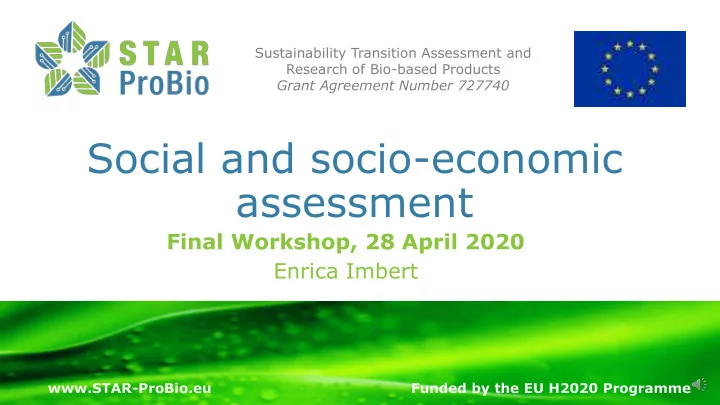

Sustainability Transition Assessment and Research of Bio-based Products Grant Agreement Number 727740 Social and socio-economic assessment Final Workshop, 28 April 2020 Enrica Imbert www.STAR-ProBio.eu Funded by the EU H2020 Programme
Overall Goal: assess the socio-economic dimensions of bio-based products, through the Social Life Cycle Assessment (S-LCA) methodology, in order to make the assessment comparable with the analysis carried out by the WPs involved with Environmental Life Cycle Assessment (E-LCA) and Life Cycle Costing (LCC) Four Main Steps: ▪ selecting socio-economic items relevant to bio-based products (impact categories, subcategories and related indicators) in relation to different stakeholder categories ▪ developing a tailored S-LCA scheme to measure the most significant socio-economic impact of bio-based products ▪ testing our S-LCA scheme on a case-study ▪ identifying key socio-economic priorities for sustainable bio-based products end-of-life management www.STAR-ProBio.eu Funded by the EU H2020 Programme
1 st Step Activities Four interactive • 1° literature • 9 impact workshops review round categories • Stakeholder • 2° literature • 22 subcategories mapping and review round analysis Preliminary list of value Validated list items www.STAR-ProBio.eu Funded by the EU H2020 Programme
Workshops: Rome, Berlin, Santiago de Compostela and Turin Validation of the social and socio- 1 economic impact categories and subcategories list Brainstorming on the relevant 2 social indicators Workshops composition Location Participants Stakeholder categories Involvement C GS LC VC W A I IP UP Rome (Unitelma Sapienza) 6 1 2 1 1 1 4 2 Santiago de Compostela (USC) 8 1 2 2 3 5 2 1 Berlin (TUB) 9 4 3 2 7 2 Turin (IFIB) 9 1 4 1 1 1 2 1 6 Note: Stakeholder categories - Consumers (C); General Society (GS); Local Community (LC); Value chain actors (VC); Workers (W). Involvement towards biobased products - Active (A); Inactive (I); Intentionally Passive (IP); Unintentionally Passive (UP). www.STAR-ProBio.eu Funded by the EU H2020 Programme
1 st Step Outcome 8 validated impact categories Health and safety Social benefits- Migration social security Human Social rights acceptability Impact categories Fair competition Food in the security market Labour rights Contribution and decent to economy work Note: blue circle = should be considered; green circle = can be considered; grey circle can be removed www.STAR-ProBio.eu Funded by the EU H2020 Programme
1 st Step Outcome 15 validated subcategories www.STAR-ProBio.eu Funded by the EU H2020 Programme
2 nd Step Activities ▪ Developing a flexible S-LCA scheme to be adapted to the different bio-based products ▪ Adapting the scale-based methodology proposed in the Handbook for Product Social Assessment (Goedkoop et al., 2018) Stakeholder Impact Impact Performance Score category categories subcategories indicators www.STAR-ProBio.eu Funded by the EU H2020 Programme
2 nd Step Outcome Rules of our S-LCA scheme . • A minimum number of impact subcategories should be covered, at least 11 of the 14 impact categories Pass • The final score should be over or at least 0 www.STAR-ProBio.eu Funded by the EU H2020 Programme
3 rd Step Activities ▪ Applying our methodology to a selected bio-based product: PLA packaging film, one of the STAR-ProBio case studies ▪ Developing a questionnaire designed to include different life cycle stages and different stakeholder categories www.STAR-ProBio.eu Funded by the EU H2020 Programme
3 rd Step Outcome PLA packaging film www.STAR-ProBio.eu Funded by the EU H2020 Programme
4 th Step Activities ▪ Deepening the analysis of the validated subcategories and indicators pertaining to the end-of-life (EoL) stage ▪ Developing an asset-based model focused on EoL treatment of bio-based products, involving different stakeholder categories (i.e. academics, trade associations, policy makers and waste management companies) from geographically and culturally distant European regions (e.g. Germany, Greece, Italy, Spain and Sweden) ▪ Testing the model on PLA packaging film www.STAR-ProBio.eu Funded by the EU H2020 Programme
4 th Step Outcome key community priorities for sustainable EoL management of PLA-based packaging film Application of socio-economic indicator for EoL strategy (SEI-EoL) www.STAR-ProBio.eu Funded by the EU H2020 Programme
References ➢ USC and Unitelma (2019) Deliverable D6.3: Criteria and indicators developed for conducting S-LCA social impact assessment. http://www.star-probio.eu/research/ ➢ Unitelma, TUB, SEPA and USC (2019) Deliverable D6.4: Report on end-of-life social and socio-economic assessment. http://www.star-probio.eu/research/ www.STAR-ProBio.eu Funded by the EU H2020 Programme
Acknowledgements Contact ▪ Universidade de Santiago de Enrica Imbert Compostela ▪ enrica.imbert@unitelma.it ▪ Technische Universitaet Berlin www.star-probio.eu ▪ Swedish Environmental Protection Agency – Naturvardsverket This project is funded by the European Union’s Horizon 2020 Research and innovation action under grant agreement No 727740 with the Research Executive Agency (REA) - European Commission. Duration: 36 months (May 2017 – April 2020). Work Programme BB-01-2016: Sustainability schemes for the bio-based economy www.STAR-ProBio.eu Funded by the EU H2020 Programme
Recommend
More recommend